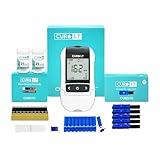Blood Glucose Meters for Seniors
Managing blood sugar levels is vital for seniors, particularly those with diabetes. Blood glucose meters are essential tools that allow seniors to monitor their glucose levels at home, helping them maintain their health and prevent complications.
Current The Best Blood Glucose Meter
As an Amazon Partner, we may be compensated if you make a purchase – at no additional cost to you. Last update on 2025-10-12 / Affiliate links / Images from Amazon Product Advertising API
Blood Pressure Monitors for Seniors: A Comprehensive Guide
Monitoring blood pressure is a crucial aspect of health management for seniors. As individuals age, they become more susceptible to hypertension and related cardiovascular issues. Utilizing blood pressure monitors can help seniors keep track of their blood pressure levels, ensuring timely intervention and management. This article explores the various types of blood pressure monitors, their benefits, and tips for choosing the right one for seniors.
Why Blood Pressure Monitoring is Important for Seniors
As seniors age, their risk for high blood pressure, or hypertension, increases due to changes in blood vessel elasticity, lifestyle factors, and potential chronic conditions. Regular monitoring can:
- Detect Hypertension Early: Early detection allows for prompt management and treatment.
- Manage Chronic Conditions: Helps in managing existing conditions like heart disease and diabetes.
- Prevent Complications: Reduces the risk of complications such as stroke, heart attack, and kidney disease.
- Empower Patients: Encourages seniors to take an active role in their health management.
Types of Blood Pressure Monitors
- Upper Arm Monitors:
- Automatic Upper Arm Monitors: These are the most commonly recommended for accuracy and ease of use. They come with an inflatable cuff that goes around the upper arm and a digital display that shows the readings.
- Manual Upper Arm Monitors: These require a stethoscope and are less commonly used at home due to the complexity of obtaining a reading.
- Wrist Monitors:
- Automatic Wrist Monitors: These are portable and convenient, especially for seniors who travel frequently. They measure blood pressure at the wrist and are easier to put on than upper arm cuffs. However, they may be less accurate if not used correctly.
- Finger Monitors:
- Automatic Finger Monitors: These are the least recommended due to their lower accuracy. They are, however, very portable and easy to use.
Key Features to Look For
When selecting a blood pressure monitor for seniors, consider the following features to ensure ease of use and accuracy:
- Ease of Use:
- Large, clear digital display for easy reading.
- Simple, one-button operation for convenience.
- Memory and Data Storage:
- Ability to store multiple readings to track changes over time.
- Some models offer connectivity to smartphones or computers for advanced data tracking.
- Cuff Size and Comfort:
- Ensure the cuff fits the upper arm or wrist comfortably.
- Adjustable cuffs for different arm sizes.
- Accuracy:
- Look for monitors validated by medical authorities or recommended by healthcare providers.
- Ensure proper use to maintain accuracy, particularly with wrist and finger monitors.
- Additional Features:
- Irregular heartbeat detection to alert users of potential issues.
- Multiple user profiles for households with more than one person monitoring their blood pressure.
Tips for Accurate Blood Pressure Measurement
To ensure accurate readings, seniors should follow these guidelines:
- Rest Before Measurement:
- Sit quietly for at least 5 minutes before taking a reading.
- Proper Positioning:
- Sit with feet flat on the floor and back supported.
- Rest the arm at heart level, either on a table or supported by a cushion.
- Avoid Caffeine and Smoking:
- Refrain from caffeine, smoking, or strenuous exercise at least 30 minutes before measuring blood pressure.
- Consistent Timing:
- Measure blood pressure at the same time each day for consistency.
- Record Readings:
- Keep a log of readings to share with healthcare providers.
Benefits of Regular Blood Pressure Monitoring for Seniors
Regular monitoring of blood pressure offers numerous benefits, including:
- Early Detection of Hypertension: Allows for timely medical intervention and lifestyle adjustments.
- Better Management of Chronic Conditions: Facilitates better control of conditions like hypertension, heart disease, and diabetes.
- Empowerment and Peace of Mind: Gives seniors a sense of control over their health and helps reduce anxiety related to health issues.
- Improved Communication with Healthcare Providers: Provides accurate data to healthcare providers, aiding in more effective treatment plans.
Conclusion
Blood pressure monitors are essential tools for seniors to manage their health proactively. With the right device and proper usage, seniors can monitor their blood pressure accurately and take necessary steps to maintain their well-being. Regular monitoring, combined with healthy lifestyle choices and medical guidance, can significantly improve quality of life and reduce the risk of serious health complications. When choosing a blood pressure monitor, prioritize ease of use, accuracy, and features that meet individual needs.
Last Updated on August 3, 2024 by ingmin




